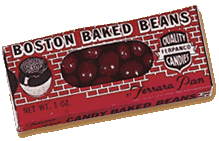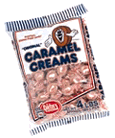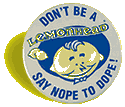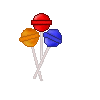|
The
History and Links |
||
Click one of the links below to go directly to that section! Andes
About
Me |
Andes In 1950, the Crème de Menthe candy piece was added to the Andes
stores' product line. This three layer mint has remained the foundation
of the brand and today is the #1 After Dinner Mint on the market. Over
the years, Andes has expanded to include a variety of flavors and
packages including the popular Cherry Jubilee, Mint Parfait and Toffee
Crunch Thins.
Nello Ferrara, the son of Salvatore Ferrara, created the famous Atomic FireBall in 1954. At this time in his life he had the idea to develop a spicy candy. When the product was presented to the candy industry, the capacity at Ferrara Pan was limited to 200 cases per day. Within three weeks of sending samples to Ferrara Pan brokers, orders were rolling in at a rate of over 50,000 cases per day, far beyond the capacity Ferrara Pan could handle at that time. The Atomic FireBall was developed using the hot panned candy process. This process involves building candy pieces from single grains of sugar and tossing them into revolving pans while adding flavor, color and other candy ingredients. This process continues until the pieces become the desired size.
History
on Boston Baked Beans "The Boston Baked Bean" is a generic name used throughout the candy industry for sugar coated peanuts. Ferrara Pan Candy Company developed their line of Boston Baked Beans in the early 1930's, right around the same time that Red Hots were introduced. The Boston Baked Bean is created using the cold panned candy process. This process involves building candy pieces from single units, such as peanuts, and tossing them into revolving pans while adding flavor, color and other candy ingredients. This process continues until the pieces become the size desired. Other companies attempted to compete in the market, but Ferrara Pan has risen above their competitors and earned world-wide recognition for their Boston Baked Bean. Ferrara Pan is known for making the highest quality and best tasting sugar coated peanuts in the world. In addition to Boston Baked Bean, Ferrara Pan Candy Company makes numerous types of candy, such as hard candies, gummies, and jellies.
Tootsie Roll Industries acquired Charleston Chew from the Warner-Lambert Company in 1993. The Charleston Chew was originally launched in 1922 by its previous owner, the Fox-Cross Candy Company, and was named after a dance craze in full swing at the time -- the Charleston. Currently, Charleston Chew is produced in Tootsie Roll Industries' Cambridge, Massachusetts Plant.
D. L. Clark's first steady job was in a frame factory for $1.50 a week. After that he worked in various occupations including; paint manufacturing, rolling mills, art glass factories, fish markets, wholesale notions, and delivery wagons among many others. He noted that in addition to what he learned in Business College; he had been learning through "extensive travels both in America and in many foreign countries, and the best of all teachers, the School of Experience." Clark entered the candy business working for a small candy manufacturer from New York. After three years as a traveling salesman with a "country wagon"; he bought the peddling wagon, horses, and merchandise and went into business for himself. The D. L. Clark Company was founded in 1886 when Clark started manufacturing candy in two back rooms of a small house in Allegheny, Pennsylvania, now Pittsburgh's North Side. When David Clark started selling candy in the streets of Pittsburgh, the prospect of becoming a giant in the confectionery industry was far from his thoughts. However, during his lifetime (1864-1939), the D. L. Clark Company became a leading candy manufacturer and the Clark bar emerged as one of the nation's favorite treats. Clark's business grew steadily and in 1911 the company moved to larger quarters at a cracker factory on Pittsburgh's North Side. The D. L. Clark Company continued to expand and prosper at that location for 75 years, manufacturing some of America's best-known candies. The company experimented with a variety of ingredients that had never been used in candy before. Clark introduced confections filled with coconut, mint and peanut butter and was a leader in marketing candy bars. Three of its best creations are Clark, Zagnut, and Clark Coconut Crunch bar. Clark scored an important marketing success when it introduced the five-cent-sized Clark bar. Initially, the bar was individually wrapped to facilitate shipment of candy to American troops during World War I. The Clark bar became extremely popular with the soldiers and its popularity carried over to the general public in the years following the war. By 1920 the D. L. Clark Company was making about 150 different types of candy, including several five-cent bars, specialty items and a bulk candy line. Clark also manufactured chewing gum and in 1921 incorporated the Clark Brothers Chewing Gum Company, makers of Teaberry and Tendermint. However, by 1931, the candy bar business had grown so large that Clark decided to specialize exclusively in candy bars. In 1955, the Clark family sold their candy business to the Beatrice Food Company, which operated the company until 1983. Beatrice had also purchased the Slo Poke, Black Cow and Milk Dud rights from Halloway Company and moved the production of these items to the Clark plant in Pittsburgh. In 1983, Leaf, Inc., which operated 11 candy and gum plants in the United States, acquired the confectionery division of Beatrice foods, including Clark. When Leaf, Inc. announced plans to move the candy operations from Pittsburgh, the city protested. The candy plant and rights to Clark, Slo Poke and Black Cow were sold to Michael Carlow and D. L. Clark became part of the Pittsburgh Food and Beverage Company. In 1992, Carlow also acquired the Wayne Candy Company of Ft. Wayne Indiana, makers of the Bun Bars. Although Carlow attempted to save D. L. Clark Company, the company slowly declined in sales and market position and in February of 1995 Pittsburgh Food and Beverage was thrown into bankruptcy. The company was shut down for several months and assets were being divested. In June of 1995, Jim Clister purchased the D. L. Clark Company, Clister renamed the company, Clark Bar America and reestablished distribution. New product lines were also selectively introduced including Winter Clark, Clark Dark, and the Yoo-hoo Candy Bar, while the Slow-Poke and Black Cow brands were discontinued. However, Clark Bar America again fell into financial difficulty and in May of 1999, New England Confectionery Company (NECCO) purchased the assets of Clark Bar America. Necco itself has a rich history of candy making and is the oldest candy manufacturer in the United States. Clark now joins the Necco family of products including Necco Wafers, SkyBar, Haviland Thin Mints, Mary Janes, and many others. Necco is committed to manufacturing the same quality candy first manufactured by D. L. Clark in 1886 and to expanding the brand to consumers in the marketplace.
Caramel Creams In the early 1940's Mr. Goetze decided to focus his attention to the manufacturing of one item that would be the model of consistency and quality. It was at that time that the company began to manufacture Caramel Creams exclusively. In 1958, the company was incorporated under the name Goetze's Candy Company, Inc. Today, the company is located in the same building that housed the original manufacturing plant in 1928. Production has grown and the building has expanded, but the same dedication to quality and customer service has prevailed throughout the century. We have progressed from the initial horse and cart deliveries around downtown Baltimore to container shipments that reach destinations such as Europe, Asia, Australia and the like. With the celebration of our 100th birthday in 1995, Goetze's Candy Company is still not ready for the rocking chair. Consistent sales growth, and a commitment to customer service, has allowed us to set our sights on the next 100 years.
Tootsie Roll Industries acquired the Charms Company in 1988. The Charms
products consist of Blow Pops, Charms Squares, Charms Pops, and Zip-A-Dee-Doo-Da
Pops. Tootsie Roll Industries produces more than 16 million lollipops a
day, making the company the world's largest lollipop producer. Currently,
the Charms line is produced in Tootsie Roll Industries' Covington,
Tennessee Plant. Dum Dum Pops were originated by Akron Candy Company in Bellevue, Ohio, in 1924. I.C. Bahr, the early sales manager of the company, named the ball-shaped candy on a stick and figured Dum Dum was a word any child could say. Spangler Candy purchased the Dum Dum Pop in 1953 from Akron Candy Company and moved the operation to Bryan, Ohio .
Tootsie Roll formally introduced and trademarked Mason Dots in 1945. Currently, Tootsie Roll Industries' produces 14 million Mason Dots and Crows a day in their Chicago Plant. Jaw Busters, The Original Jaw Breaker No wonder
Jawbusters take so long to eat -- it takes from 14 to 19 days to make a
single Jaw Buster, The Original Jawbreaker. Jawbuster's candy are
created using the hot panned process. This process involves building
candy pieces from single grains of sugar and tossing them into revolving
pans while adding flavor, color and other candy ingredients. This
process continues until the pieces become the desired size. The name "Jawbreaker" is a generic name used by the candy industry to indicate a piece of hard candy. Prior to when Ferrara Pan began making the product, many people in the candy industry also developed a so-called "Jawbreaker". Once Ferrara Pan became successful with the Jaw Breaker product, they began to establish credibility which led to creating a prominent brand within the company. In the past year, the name Jawbreakers has been changed to Jawbusters, The Original Jawbreakers, to add a new twist to the product.
Tootsie Roll Industries acquired Junior Mints from the Warner-Lambert Company in 1993. James Welch, the brother of Robert Welch who originally discovered Sugar Daddy and Sugar Babies, developed Junior Mints. Launched into the market in 1949, Welch named the candy specifically after his favorite Broadway stage performance, Junior Miss. Tootsie Roll Industries produces an average of 15 million Junior
Mints a day out of their Cambridge, Massachusetts Plant. Lemonheads Lemonheads
were named and formulated by Ferrara Pan Candy Company. The
formula was developed in 1962 using the same method as Red Hots, another
Ferrara Pan candy product. Both of these candies are made using
the cold panned process. This process involves building candy
pieces from candy centers and tossing them into revolving pans while
adding flavor, color and other candy ingredients.
Do you know why the Lifesaver has a hole in the middle and it's round? Mr. Crane had experimented with a machine originally designed to make pills in the shape of little O's. But, instead of pills he created round hard candy with a hole in the middle. Why? - just to be different! The name Lifesaver comes from the appearance of the candy. Mr. Crane soon realized that the O shaped peppermints he was producing looked like the lifesaver devices used to save people from drowning. The first Lifesaver package was designed by using a round paper board tube that would hold a stack of candies. He then added the label advertising his new Lifesaver candies. Mr. Crane choose the following marketing slogan to sell his Lifesaver-"Crane's Peppermint Lifesaver... 5 cents ...For that Stormy Breath." Mr. John Nobel, an advertising salesman, was so impressed with the taste, clever shape, name and package of the Lifesaver that he tried to convince Mr. Crane to do more in the way of promotion- but, he refused. Mr. Crane's real love was chocolate. Instead Mr. Crane sold the mint candy idea - along with the converted pill machine to Mr. Noble. Failure was Mr. Nobel's first achievement. What he hadn't realized was that he had tried fresh Lifesaver- when left on the shelf for over a week they became stale and tasteless. He had to find a way to keep the candy fresh and then he had to convince people to try them again. He did the following first he invented the tin foil wrapping, then he replaced the old with the new and gave away free smaller samples on the street encouraging people to give Lifesaver one more chance. This led to success. Because he was an advertiser, he also continued to work at new ways of promotion. His idea was to sell them close to the cash register- if people had a nickel they could buy his candies. This method is continued today. As you can see, Lifesavers have changed over the years, for the better (if I do say so myself). So, if you have not had the opportunity to taste this delectable treat, drive, bike, run, take the bus, do whatever you can to get to your nearest candy shop and purchase a roll of Lifesavers.
In
the early 1930's, Ferrara Pan Candy Company created the famous Red Hot
using the cold panned candy method. The idea of a piece of cinnamon
hard candy was developed prior to the production of Ferrara Pan's Red Hots.
The name "cinnamon imperials" is a generic name used by the
candy industry to indicate a piece of cinnamon hard candy.
Tootsie Roll is a chocolatey candy product wrapped in a nostalgic
package that has Today, Tootsie Roll continues to produce the same recipe that Leo
Hirshfield first developed. Although Tootsie Roll continues to sell the
famous penny piece, Tootsie Rolls are now offered in a variety of shapes
and sizes to meet every consumer need. Tootsie Pops may best be remembered today by consumers trying to
answer that question... "Mr. Owl, how many licks does it take to
get to the Tootsie Roll center of a Tootsie Pop?" To date, we at
Tootsie Roll have answered more than 25,000 letters, each with a
response unique to the author. The real answer may never be known...
More Coming Soon... Connected2Christ created by Erin Carter Created Monday, September 22,2002
|
 In May of 2000, the Charms Division of Tootsie Roll Industries acquired
the Andes brand from Brock & Brach Confections. Originally founded
in 1921, Andy's Candies produced a variety of boxed chocolates which
were sold on the store premises. As the business grew over the years a
factory was built and the name was changed to Andes Candies.
In May of 2000, the Charms Division of Tootsie Roll Industries acquired
the Andes brand from Brock & Brach Confections. Originally founded
in 1921, Andy's Candies produced a variety of boxed chocolates which
were sold on the store premises. As the business grew over the years a
factory was built and the name was changed to Andes Candies.


 In
1985, Tootsie Roll Industries acquired Cellas' Confections, Inc., a
premium manufacturer of chocolate covered cherries. Currently, Cella's
are produced in Tootsie Roll Industries' New York Plant, where they have
been manufactured since 1864.
In
1985, Tootsie Roll Industries acquired Cellas' Confections, Inc., a
premium manufacturer of chocolate covered cherries. Currently, Cella's
are produced in Tootsie Roll Industries' New York Plant, where they have
been manufactured since 1864.

 Maryland.
The company was then known as The Baltimore Chewing Gum Company.
Maryland.
The company was then known as The Baltimore Chewing Gum Company.
 Marshmallow
Circus Peanuts were invented in the 1800's. These peanuts have
been produced by many confectionery manufacturers over the years. They
were originally introduced as Spring candy items in the then dominant 5
cent and 10 cent variety stores. Many other unwrapped penny
candies were also available. The product at that time was
considered a Spring seasonal item. However, with the development
of polyethylene film in the late 1940's, it became possible to offer
Circus Peanuts on a year-round basis.
Marshmallow
Circus Peanuts were invented in the 1800's. These peanuts have
been produced by many confectionery manufacturers over the years. They
were originally introduced as Spring candy items in the then dominant 5
cent and 10 cent variety stores. Many other unwrapped penny
candies were also available. The product at that time was
considered a Spring seasonal item. However, with the development
of polyethylene film in the late 1940's, it became possible to offer
Circus Peanuts on a year-round basis.
 In
June of 1972, Tootsie Roll Industries acquired the Mason Division of
Candy Corporation of America. The acquisition added two famous candies
to the Tootsie Roll family - Mason Dots and Crows. Crows were originally
invented in the 1890's by founders Ernest Von Au and Joseph Maison. The
product was originally to be called Black Rose, but when the name was
given orally to a printer, he heard the name as Black Crows, and so he
printed up wrappers with that name on them.
In
June of 1972, Tootsie Roll Industries acquired the Mason Division of
Candy Corporation of America. The acquisition added two famous candies
to the Tootsie Roll family - Mason Dots and Crows. Crows were originally
invented in the 1890's by founders Ernest Von Au and Joseph Maison. The
product was originally to be called Black Rose, but when the name was
given orally to a printer, he heard the name as Black Crows, and so he
printed up wrappers with that name on them.

 The process continues until the pieces become the desired size.
The Lemonhead was created in an attempt to make a round sour candy using
a similar process as the Red Hot. The Lemonhead is the most
successful candy of its time. Currently, Ferrara Pan produces
approximately 500 million Lemonheads per year. Millions of people
around the world are bridged together as they enjoy eating the round
sour candy known as the Lemonhead. In the past few years, Ferrara
Pan Candy Company created a "Headline" assortment including,
Lemonhead, Grapehead, Orangehead, Applehead and Cherryhead.
The process continues until the pieces become the desired size.
The Lemonhead was created in an attempt to make a round sour candy using
a similar process as the Red Hot. The Lemonhead is the most
successful candy of its time. Currently, Ferrara Pan produces
approximately 500 million Lemonheads per year. Millions of people
around the world are bridged together as they enjoy eating the round
sour candy known as the Lemonhead. In the past few years, Ferrara
Pan Candy Company created a "Headline" assortment including,
Lemonhead, Grapehead, Orangehead, Applehead and Cherryhead.  What's
round, has a hole in the middle, and comes in many flavors and colors? If
you guessed Lifesaver then you are right! Clarence Crane invented the
Lifesaver candy in 1913. He invented the Lifesaver while trying to sell
chocolates in the summer. Why? What's the connection? Mr. Crane had a
problem - his chocolates would melt into gooey blobs in the summer. He
needed an alternative to the mess and his solution was the Lifesaver.
What's
round, has a hole in the middle, and comes in many flavors and colors? If
you guessed Lifesaver then you are right! Clarence Crane invented the
Lifesaver candy in 1913. He invented the Lifesaver while trying to sell
chocolates in the summer. Why? What's the connection? Mr. Crane had a
problem - his chocolates would melt into gooey blobs in the summer. He
needed an alternative to the mess and his solution was the Lifesaver. The
cold panned process involves building candy pieces from candy centers and
tossing them into revolving pans while adding flavor, color and other
candy ingredients. This process continues until the pieces become
the desired size. Red Hots are a registered trademark of Ferrara Pan
Candy Company and is yet another example of Ferrara Pan's commitment to
quality in the candy industry.
The
cold panned process involves building candy pieces from candy centers and
tossing them into revolving pans while adding flavor, color and other
candy ingredients. This process continues until the pieces become
the desired size. Red Hots are a registered trademark of Ferrara Pan
Candy Company and is yet another example of Ferrara Pan's commitment to
quality in the candy industry.  become part of Americana for over 100 years. In 1896,
Leo Hirshfield, an Austrian immigrant, came to the United States to set
up a small candy store in New York City, where he hand-rolled and
wrapped a candy creation that he had brought from the old country. Leo
Hirshfield decided this product should be named after his daughter
Clara, whose nickname was Tootsie. Tootsie Roll became the first wrapped
penny candy in America.
become part of Americana for over 100 years. In 1896,
Leo Hirshfield, an Austrian immigrant, came to the United States to set
up a small candy store in New York City, where he hand-rolled and
wrapped a candy creation that he had brought from the old country. Leo
Hirshfield decided this product should be named after his daughter
Clara, whose nickname was Tootsie. Tootsie Roll became the first wrapped
penny candy in America.
 In 1931, the famous
Tootsie Pop was born. This pop that contains the chewy Tootsie Center
was revolutionary because it was the first soft centered lollipop. Over
the years Tootsie Pop has itself become part of American history.
Enjoyed by kids of all ages, the brand received extra exposure in the
1970's with Telly Savalas, as Kojak, eating Tootsie Pops as he solved
crimes.
In 1931, the famous
Tootsie Pop was born. This pop that contains the chewy Tootsie Center
was revolutionary because it was the first soft centered lollipop. Over
the years Tootsie Pop has itself become part of American history.
Enjoyed by kids of all ages, the brand received extra exposure in the
1970's with Telly Savalas, as Kojak, eating Tootsie Pops as he solved
crimes.